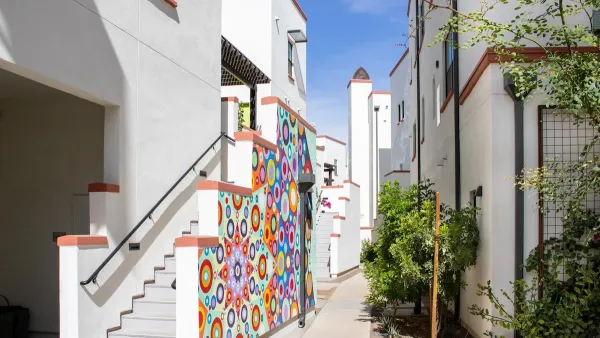Six years ago, the 620-square-mile city had not one bike lane and forty McDonald's franchises.
When Oklahoma City mayor Mick Cornett read that his hometown topped a list of America's fattest cities, he challenged himself and the city to collectively lose one million pounds.
"I was seeing how we had designed the city around the automobile. No one walked anywhere—we didn’t have sidewalks to any great extent in the suburbs," Cornett told Men's Fitness. "Our inner city grade schools didn’t even have gymnasiums. That was the culture that we had created for ourselves."
The mayor hired Jeff Speck to advise him on what could be done. Speck determined that the city had twice as many car lanes as it needed. Further, the one-way system of highways encouraged high speeds and severely impacted walkability. The mayor recognized that the city's health problems were directly related to the walkability problem.
In addition to building a convention center and other capital improvement projects, MAPS 3, as it is called, would pay to address the city's obesity epidemic by building bike lanes, sidewalks and health and wellness facilities as well as a downtown public transit system. Instead of a soda tax, which would have been politically unpopular in such a conservative town, the citizens of Oklahoma City agreed to finance the project partially through the extension of an expiring sales tax program for a period of seven years.
"The experiment is unusual in terms of its ambition, breadth and cost, all of which take it beyond anything being attempted by other American cities in the fight against fat," reports Ian Birell.
The city reached is goal of losing one million pounds, and the mayor shed nearly forty himself. The once-dilapidated downtown district went from having one hotel to fifteen.
However, Birrell is cautiously optimistic. "Yet the key question is whether even such valiant and wide-ranging efforts can dent such a huge health problem, one needlessly killing so many people on the planet."
FULL STORY: The Fat City That Declared War On Obesity

Analysis: Cybertruck Fatality Rate Far Exceeds That of Ford Pinto
The Tesla Cybertruck was recalled seven times last year.

National Parks Layoffs Will Cause Communities to Lose Billions
Thousands of essential park workers were laid off this week, just before the busy spring break season.

Retro-silient?: America’s First “Eco-burb,” The Woodlands Turns 50
A master-planned community north of Houston offers lessons on green infrastructure and resilient design, but falls short of its founder’s lofty affordability and walkability goals.

Test News Post 1
This is a summary

Analysis: Cybertruck Fatality Rate Far Exceeds That of Ford Pinto
The Tesla Cybertruck was recalled seven times last year.

Test News Headline 46
Test for the image on the front page.
Urban Design for Planners 1: Software Tools
This six-course series explores essential urban design concepts using open source software and equips planners with the tools they need to participate fully in the urban design process.
Planning for Universal Design
Learn the tools for implementing Universal Design in planning regulations.
EMC Planning Group, Inc.
Planetizen
Planetizen
Mpact (formerly Rail~Volution)
Great Falls Development Authority, Inc.
HUDs Office of Policy Development and Research
NYU Wagner Graduate School of Public Service




























